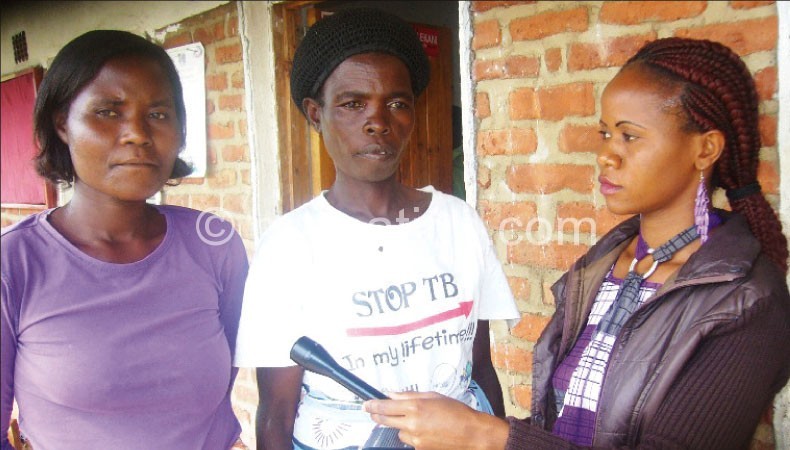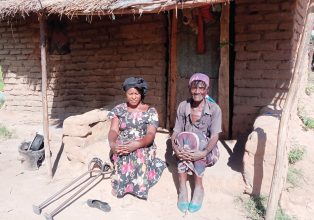Drug adherence for successful TB treatment

On a hot morning, wearing a white T-shirt labelled ‘Stop TB’, Eveless Makuya tells her story of living with tuberculosis 14 years ago.
“God is mysterious. I was nearly incapacitated by TB. I could not do anything apart from sleeping in agony every day at home. My children were greatly affected by my illness because I was the bread winner,” says Makuya.
The 52-year-old widow and mother of three, who lives in an informal settlement of Vivi-Chizeze, Traditional Authority Chimutu in Lilongwe, is currently vice-chairperson of Tikondane Anti-TB Club. She also joined an HIV support group—a group of people living with HIV and Aids—in 2000.
Her husband died in 1997. Prior to his death, she was not involved in any income generating activity because he provided for the family. Now that he was gone, Makuya started selling tomatoes to support her family.
Her children now aged 31, 29 and 27 were then able to attend school and had their basic needs provided for from the tomato business. But Makuya’s illness dealt them a severe blow.
“I would get sick and was mostly diagnosed with malaria, yet the prescribed medicine was not effective. I started experiencing persistent headache, cough, backaches and pneumonia on a regular basis,” she says.
Makuya would also get night sweats even in cold weather. Her relatives concluded that she was bewitched and took her to several traditional healers, but her health continued to worsen.
She was later taken to Chiwamba Health Centre where medical personnel referred her to Bwaila Hospital (then Bottom Hospital) in Lilongwe for further examination.
“I went to Bwaila Hospital in early 2000 where my sputum was taken for TB testing. The results showed that I had TB and I was immediately given a two-week TB drug starter pack as a first line treatment which helps to stabilise TB patients,” says Makuya.
After completing the starter pack, she was enrolled on an eight-month treatment regimen, which she was instructed to take consistently without missing a dose.
With the support of her guardian, she diligently followed the treatment as directed by health personnel.
“There were times I nearly stopped taking the medication because of side effects. It affected my body and the colour of my eyes changed,” she recalls.
She completed treatment and the hospital confirmed that her TB had been successfully treated.
“Some people think that there is no treatment for TB, but that is not true. One needs to stop drinking beer, avoid sexual contact and follow medical advice. Many people go to traditional healers when they are ill, but this is dangerous because traditional doctors do not diagnose and treat TB; it is only the hospital that can do this,” says Makuya.
Perhaps one of the reasons there is little awareness of TB is poor community involvement. Representatives of some African countries at the recent International Aids Conference in Melbourne, Australia, say governments and policymakers are failing to involve communities in HIV and TB programmes, turning instead to researchers and experts to make key decisions. This issue triggered debate at the Melbourne conference which ran from 20 to 25 July.
Asked what needs to be done for TB and HIV collaborative action in the 22 high burden countries in order to reduce TB related deaths in people living with HIV and what have been the major lessons, Dr. Ritta Dlodlo, TB-HIV programmes coordinator for Stop TB says there is need to keep TB-HIV issues on the agenda.
“There are many reasons why patients with these two conditions may die. They range from late presentation or limited access to care due to poverty and stigma, to delays in diagnosis and initiation of life saving treatments. Some deaths are definitely preventable.
“I feel we need wide actions, such as increasing community awareness of TB and HIV association, HIV care and ART that are currently widely available and how people could seek help,” says Dlodlo.
She said health workers need training, support supervision and clinical mentoring to perform better.
“Again, health workers should examine their attitudes so that they are patient-centred. They also need communication skills to create good rapport with patients,” says Dlodlo.
Dr. Anthony Harries, senior adviser at the International Union Against Tuberculosis and Lung Disease, said good infection control practices in health facilities and the community, early diagnosis of drug-resistant TB and shorter and less toxic anti-TB treatment regimens can help patients to properly complete treatment.
He said better control of HIV and instituting widespread ART will be crucial to reducing the risk of TB in high HIV-prevalence areas like communities of Vivi-Chizeze.




